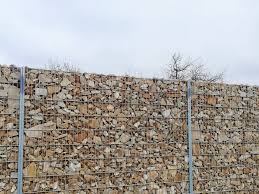Gabions are eco-friendly and flexible structures that are used for landscaping, civil engineering and erosion control. They are derived from the Italian words “gabbione,” meaning “big cage,” gabions (gabiony) are basically wire cages or baskets that are filled with stones, rocks, or other substances. They’ve been used for centuries to help stabilize soil and manage the flow of water.
Structure and Construction
Gabions generally consist of circular or rectangular wire mesh cages that are typically constructed from galvanized steel or PVC-coated wires to prevent corrosion. The mesh is woven in a way that creates a durable and flexible container capable of holding a variety of fill materials. The size of the gabion depends on the application, ranging from small units for landscaping to larger ones for structural support.
Applications
Erosion Control: Gabions are commonly used to prevent erosion of soil along riverbanks, hillsides, and roads. By stabilizing the ground and taking the pressure of flowing water they decrease the chance of landslides and erosion.
Retaining Walls Gabions serve as efficient walls to hold back soil movement. They are particularly advantageous in areas that have steep slopes or unstable soil, providing both aesthetic and structural support.
Noise Barriers: In urban areas, gabion walls can be used to create noise barriers along roads or railways, effectively decreasing the impact of traffic noise on nearby residential areas.
Aesthetics and Landscaping: Gabions are also popular in landscaping projects to create visually intriguing features like garden walls, seating spaces, or decorative elements. Their natural beauty and the ability to blend with the environment make them an ideal choice for a lot of designers.
Advantages
Gabions provide a variety of advantages. They are more cost-effective than traditional masonry, need minimal maintenance, and are highly durable. The permeable nature of gabions allows water to flow through, reducing hydrostatic pressure and making them suitable for areas with a high moisture content. Gabions also support plant growth, contributing to ecological restoration and enhancing the visual appeal of the surrounding.
Conclusion
Gabions are an effective and adaptable solution to a variety of landscaping and engineering challenges. Their ability to mix functionalities and aesthetics make them an ideal instrument in modern construction and environmental management. Whether employed for erosion control and retaining walls or decorative purposes gabions are still proving their worth across a broad array of different applications.

